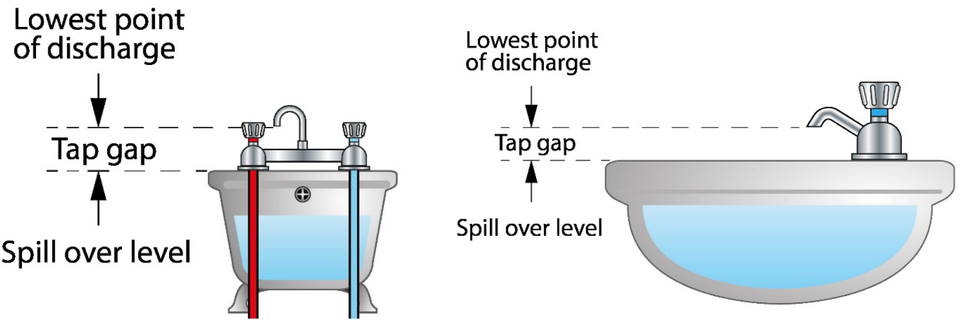All water fittings in a bathroom must be supplied via an appropriate and adequate form of backflow protection, one which is rated either equal to or higher than the highest downstream contamination risk (fluid category) for the type of backflow (back pressure or back siphonage) it is likely to be exposed to.
The backflow risks associated with bath and basin taps will vary dependent upon their use (intended or otherwise) and the environment in which they are sited.
Although ultimately it is for the local water undertaker to determine what level of backflow protection is required, typically bath and basin taps used in domestic premises are categorised as a fluid category 3 risk, whereas those installed non-domestic premises can be a fluid category 5 risk.
There are a number of ways in which to prevent backflow via a tap, one of the most commonly used forms being a tap gap. A tap gap is a ‘gap’ between the lowest point of the tap outlet and spill over level of the bath, basin or bidet, the size of which varies depending upon the diameter of the pipe supplying the tap. If a tap gap cannot be maintained or the outlet is submerged, appropriate backflow protection is required. In domestic properties a double check valve is typically used.

Fluid category 3: Type AUK2 tap gap
Tap connection size | Minimum tap gap |
Up to and including 15 mm (½”) | 20 mm |
Larger than 15 mm (½”) but smaller than 20 mm (¾”) | 25 mm |
20 mm (¾”) or larger | 70 mm |
Fluid category 5 : Type AUK3 tap gap
20 mm or twice the internal diameter of the tap connection whichever is the greater
For example: tap size | minimum tap gap |
8 mm | 20 mm |
10 mm | 20 mm |
12 mm | 24 mm |
15 mm | 30 mm |
20 mm | 40 mm |
25 mm | 50 mm |
Please note if tap is a single flow mixer tap (as opposed to a dual or bi-flow tap which has separate water paths to the end of the spout) in addition to maintaining the required tap gap single check valves will need to be installed on the pipework supplying the tap. This is to prevent cold water pressurising the hot water and hot water accessing the cold water mains supply under fault conditions.
If the installation is notifiable installation advice should be provided as part of the notification process.
If it is not notifiable there remains a legal obligation for the premises owner or occupier to ensure the plumbing work is fully compliant with the water fittings regulations, byelaws in Scotland.
We use cookies to give you the best possible experience with Water Regs UK. Some are essential to provide website functions and ensure the website is secure. We also use cookies to help us understand how people use the site and to make improvements. Click "Accept All" to enable recommended settings or click "Manage cookies" to adjust your settings. For more details, see our Cookie Policy.